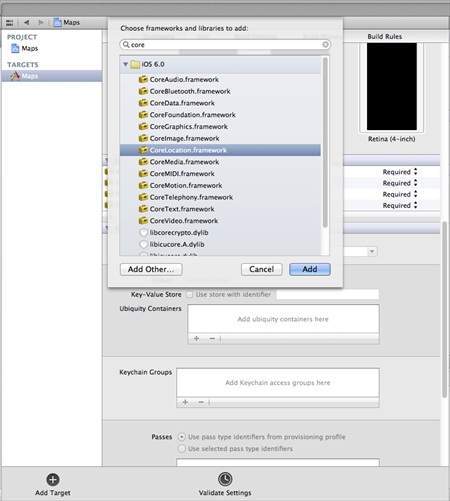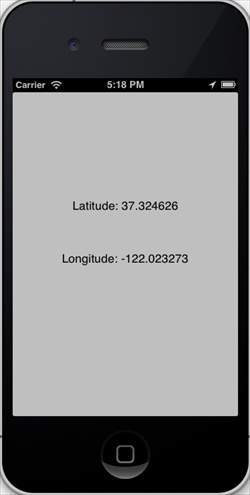- Objective-C入门教程
- iOS入门教程
- UI控制器
- 容器视图
- 内容视图
- 视图控制器
- Tab Bar接口
- 导航栏
- 安装库
- 请求与解析
- 数据保存
- 多线程

只要用户允许应用程序在核心位置框架的帮助下访问信息,无涯教程就可以在iOS中轻松找到用户的当前位置。
位置处理步骤
步骤1 - 创建一个基于View的简单应用程序。
步骤2 - 选择您的项目文件,然后选择目标,然后添加CoreLocation.framework,如下所示-

步骤3 - 在 ViewController.xib 中添加两个标签,并创建ibOutlets,分别将标签命名为 latitudeLabel 和 longitudeLabel 。
步骤4 - 通过选择File→New→File...→Object C Class创建一个新文件,然后单击下一步。
步骤5 - 将类命名为 LocationHandler ,将"sub class of"作为NSObject。
步骤6 - 选择创建。
步骤7 - 如下更新 LocationHandler.h -
#import <Foundation/Foundation.h> #import <CoreLocation/CoreLocation.h> @protocol LocationHandlerDelegate <NSObject> @required -(void) didUpdateToLocation:(CLLocation*)newLocation fromLocation:(CLLocation*)oldLocation; @end @interface LocationHandler : NSObject<CLLocationManagerDelegate> { CLLocationManager *locationManager; } @property(nonatomic,strong) id<LocationHandlerDelegate> delegate; +(id)getSharedInstance; -(void)startUpdating; -(void) stopUpdating; @end
步骤8 - 如下更新 LocationHandler.m -
#import "LocationHandler.h" static LocationHandler *DefaultManager = nil; @interface LocationHandler() -(void)initiate; @end @implementation LocationHandler +(id)getSharedInstance{ if (!DefaultManager) { DefaultManager = [[self allocWithZone:NULL]init]; [DefaultManager initiate]; } return DefaultManager; } -(void)initiate { locationManager = [[CLLocationManager alloc]init]; locationManager.delegate = self; } -(void)startUpdating{ [locationManager startUpdatingLocation]; } -(void) stopUpdating { [locationManager stopUpdatingLocation]; } -(void)locationManager:(CLLocationManager *)manager didUpdateToLocation: (CLLocation *)newLocation fromLocation:(CLLocation *)oldLocation { if ([self.delegate respondsToSelector:@selector (didUpdateToLocation:fromLocation:)]) { [self.delegate didUpdateToLocation:oldLocation fromLocation:newLocation]; } } @end
步骤9 - 如下更新 ViewController.h ,在其中无涯教程实现了 LocationHandler委托并创建两个ibOutlet-
#import <UIKit/UIKit.h> #import "LocationHandler.h" @interface ViewController : UIViewController<LocationHandlerDelegate> { IBOutlet UILabel *latitudeLabel; IBOutlet UILabel *longitudeLabel; } @end
步骤10 - 如下更新 ViewController.m -
#import "ViewController.h" @interface ViewController () @end @implementation ViewController - (void)viewDidLoad { [super viewDidLoad]; [[LocationHandler getSharedInstance]setDelegate:self]; [[LocationHandler getSharedInstance]startUpdating]; } - (void)didReceiveMemoryWarning { [super didReceiveMemoryWarning]; //Dispose of any resources that can be recreated. } -(void)didUpdateToLocation:(CLLocation *)newLocation fromLocation:(CLLocation *)oldLocation { [latitudeLabel setText:[NSString stringWithFormat: @"Latitude: %f",newLocation.coordinate.latitude]]; [longitudeLabel setText:[NSString stringWithFormat: @"Longitude: %f",newLocation.coordinate.longitude]]; } @end
运行应用程序时,将获得以下输出-

祝学习愉快!(内容编辑有误?请选中要编辑内容 -> 右键 -> 修改 -> 提交!)
 《iOS入门教程》
《iOS入门教程》 